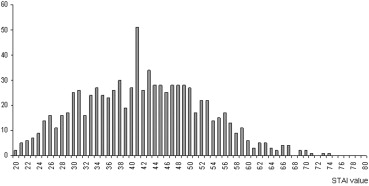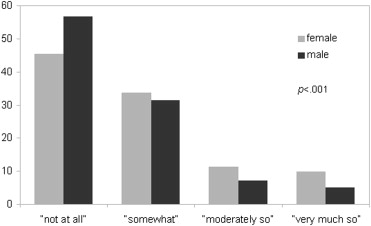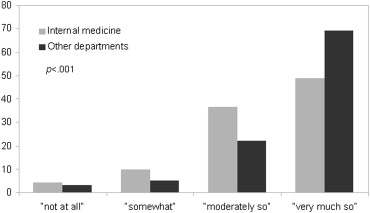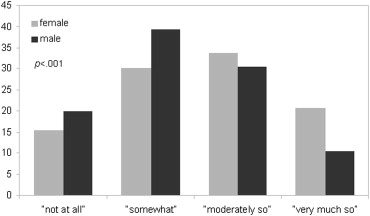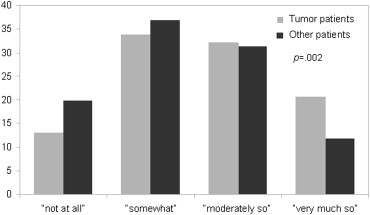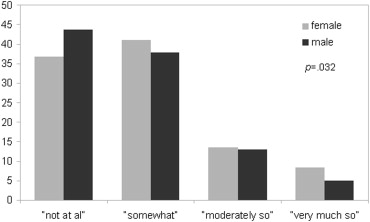Rationale and Objectives
Prospective evaluation of anxiety in patients undergoing computed tomography (CT) imaging using a standardized state-trait anxiety inventory (STAI-S) and identification of possible risk factors.
Material and Methods
During a 9-month interval, patients undergoing CT were questioned using STAI-S. Additionally, 10 questions concerning specific procedure-related features (claustrophobia, radiation, administration of contrast, and so forth) were added. Moreover, sex, age, admitting subspecialty, organ region, reason for imaging, and prior imaging studies were recorded. Statistical analysis was performed using the Student t test and linear regression analysis; significance level was set to 5%.
Results
Of 6122 patients, 825 patients undergoing CT (14%) were included (67% men; average age, 54 ± 17 years). Average STAI was 42 ± 10 with women (45 ± 11 vs. 41 ± 10; P < .001) and patients who received intravenous contrast (43 ± 10 vs. 42 ± 11; P = .021) showing significantly higher anxiety levels compared to those without contrast. Patients with investigations of their extremities (41 ± 11 vs. 43 ± 10; P = .020) and trauma patients (41 ± 11 vs. 43 ± 10; P = .006) revealed significantly lower STAI results. Patients who had never received a CT scan before showed significantly greater STAI-S values than those with repeat studies (42 ± 10 vs. 41 ± 11; P = .036). Females had greater fears concerning examination results ( P < .001), radiation exposure ( P = .032), administration of contrast ( P = .014), and claustrophobia ( P < .001). Patients with known malignancies had a significantly higher level of anxiety concerning their CT results ( P = .002).
Conclusions
Anxiety does not only occur before MRI but also occur before CT. Its sources are manifold and include communication of CT results, administration of contrast agents, radiation exposure, and claustrophobia. In this setting, women seemed to be more receptive than men.
For decades, magnetic resonance imaging (MRI) and computed tomography (CT) have been among the most common imaging methods broadly accepted by users worldwide. Although MRI is noninvasive and painless, it is subjectively perceived as strain by many patients. Reasons for this include long examination time, loud noises, the narrow tunnel and herewith linked claustrophobia, and the technical necessity to lie motionless during the scanning procedure. A number of publications analyzed MRI-associated anxiety of patients showing that claustrophobia is a key concern with incidences of up to 65% . Such anxieties can become a major problem in some patients thus making repetition of MRI sequences; pharmacologic sedation ; or other calming measures including musical entertainment , psychological preparation , and hypnosis necessary. Furthermore, in a substantial number of patients, poor imaging quality due to movement artifacts , premature termination of scanning , or complete refusal of the patient to carry out MRI must be expected. Worldwide, more than 80 billion MRI examinations are carried out per year with an estimated loss of productivity of approximately 1 billion Euros caused by anxiety-associated canceling of MRI . This problem has thus reached relevant socioeconomic and health political dimensions.
During the past years, CT scanning has highly improved in imaging quality and scanning speed. Modern CT scanners allow dynamic high-resolution and noise-reduced imaging of large body volumes within seconds. Although the length of CT gantries has increased because of growing detector sizes, they are substantially shorter compared to those of MRI. Thus, CT-related claustrophobia should only be a minor problem. Nevertheless, we also experienced extreme claustrophobia reactions in single patients during CT scanning. Although this has rarely lead to premature termination of scanning, acceptance of the examination and the will to undergo future examinations can be negatively influenced. Furthermore, many patients reported a number of additional anxiety triggers including poor information, possibility of tumor diagnosis, radiation exposure, and application of contrast media. Interestingly, research of the literature revealed that the phenomenon of patient anxiety during CT scanning with all its facets has never been systematically evaluated. As CT examinations rapidly rise in number and spread worldwide , patient anxiety might be a yet-underestimated phenomenon.
Get Radiology Tree app to read full this article<
Material and methods
Get Radiology Tree app to read full this article<
Study Group
Get Radiology Tree app to read full this article<
Get Radiology Tree app to read full this article<
Get Radiology Tree app to read full this article<
Testing Procedure
Get Radiology Tree app to read full this article<
Get Radiology Tree app to read full this article<
Get Radiology Tree app to read full this article<
Get Radiology Tree app to read full this article<
Get Radiology Tree app to read full this article<
Get Radiology Tree app to read full this article<
Get Radiology Tree app to read full this article<
Get Radiology Tree app to read full this article<
Get Radiology Tree app to read full this article<
Statistical Evaluation
Get Radiology Tree app to read full this article<
Results
Get Radiology Tree app to read full this article<
Get Radiology Tree app to read full this article<
Get Radiology Tree app to read full this article<
State-Trait Anxiety Inventory
Get Radiology Tree app to read full this article<
Get Radiology Tree app to read full this article<
Additional Questions No. 1–10
Get Radiology Tree app to read full this article<
Table 1
Detailed Answers to Additional Questions No. 1–10
No. Additional Question “not at all,” % “somewhat,” % “moderately so,” % “very much so,” % 1 I am afraid of the narrowness of the scanner. 52.8 ( n = 450) 32.0 ( n = 273) 8.5 ( n = 72) 6.7 ( n = 57) 2 I trust in the technology. 6.8 ( n = 58) 8.5 ( n = 72) 48.9 ( n = 417) 35.8 ( n = 305) 3 I know why the examination is carried out. 3.5 ( n = 30) 6.5 ( n = 55) 26.1 ( n = 222) 64.0 ( n = 545) 4 I have already heard or read a lot about the examination. 9.5 ( n = 81) 27.2 ( n = 232) 35.6 ( n = 303) 27.7 ( n = 236) 5 I am worried about the examination results. 18.4 ( n = 157) 36.2 ( n = 308) 31.6 ( n = 269) 13.8 ( n = 118) 6 I am convinced that the examination is best for me. 4.5 ( n = 38) 9.7 ( n = 83) 43.5 ( n = 371) 42.3 ( n = 360) 7 I am afraid of the radiation. 41.5 ( n = 354) 39.0 ( n = 332) 13.3 ( n = 113) 6.2 ( n = 53) 8 I am proud to have the examination carried out on me. 36.4 ( n = 310) 26.3 ( n = 224) 24.9 ( n = 212) 12.4 ( n = 106) 9 I think the examination results are important for me. 3.6 ( n = 31) 4.6 ( n = 39) 35.3 ( n = 301) 56.5 ( n = 481) 10 I am afraid of contrast medium application. ( n = 260) 36.9 ( n = 96) 38.5 ( n = 100) 16.2 ( n = 42) 8.5 ( n = 22)
Get Radiology Tree app to read full this article<
Get Radiology Tree app to read full this article<
Get Radiology Tree app to read full this article<
Get Radiology Tree app to read full this article<
Get Radiology Tree app to read full this article<
Get Radiology Tree app to read full this article<
Get Radiology Tree app to read full this article<
Get Radiology Tree app to read full this article<
Get Radiology Tree app to read full this article<
Get Radiology Tree app to read full this article<
Get Radiology Tree app to read full this article<
Discussion
Get Radiology Tree app to read full this article<
Get Radiology Tree app to read full this article<
Get Radiology Tree app to read full this article<
Get Radiology Tree app to read full this article<
Get Radiology Tree app to read full this article<
Get Radiology Tree app to read full this article<
Get Radiology Tree app to read full this article<
Get Radiology Tree app to read full this article<
Get Radiology Tree app to read full this article<
Get Radiology Tree app to read full this article<
Get Radiology Tree app to read full this article<
References
1. Eshed I., Althoff C.E., Hamm B., et. al.: Claustrophobia and premature termination of magnetic resonance imaging examinations. J Magn Reson Imaging 2007; 26: pp. 401-404.
2. Katz R.C., Wilson L., Frazer N.: Anxiety and its determinants in patients undergoing magnetic resonance imaging. J Behav Ther Exp Psychiatry 1994; 25: pp. 131-134.
3. Kilborn L.C., Labbe E.E.: Magnetic resonance imaging scanning procedures: development of phobic response during scan and at one-month follow-up. J Behav Med 1990; 13: pp. 391-401.
4. McIsaac H.K., Thordarson D.S., Shafran R., et. al.: Claustrophobia and the magnetic resonance imaging procedure. J Behav Med 1998; 21: pp. 255-268.
5. Quirk M.E., Letendre A.J., Ciottone R.A., et. al.: Anxiety in patients undergoing MR imaging. Radiology 1989; 170: pp. 463-466.
6. Hollenhorst J., Munte S., Friedrich L., et. al.: Using intranasal midazolam spray to prevent claustrophobia induced by MR imaging. AJR Am J Roentgenol 2001; 176: pp. 865-868.
7. Enders J., Zimmermann E., Rief M., et. al.: Reduction of claustrophobia during magnetic resonance imaging: methods and design of the “CLAUSTRO” randomized controlled trial. BMC Med Imaging 2011; 11: pp. 4.
8. Avrahami E.: Panic attacks during MR imaging: treatment with i.v. diazepam. AJNR Am J Neuroradiol 1990; 11: pp. 833-835.
9. Brennan S.C., Redd W.H., Jacobsen P.B., et. al.: Anxiety and panic during magnetic resonance scans. Lancet 1988; 2: pp. 512.
10. Bluemke D.A., Breiter S.N.: Sedation procedures in MR imaging: safety, effectiveness, and nursing effect on examinations. Radiology 2000; 216: pp. 645-652.
11. Slifer K.J., Penn-Jones K., Cataldo M.F., et. al.: Music enhances patients’ comfort during MR imaging. AJR Am J Roentgenol 1991; 156: pp. 403.
12. Quirk M.E., Letendre A.J., Ciottone R.A., et. al.: Evaluation of three psychologic interventions to reduce anxiety during MR imaging. Radiology 1989; 173: pp. 759-762.
13. Friday P.J., Kubal W.S.: Magnetic resonance imaging: improved patient tolerance utilizing medical hypnosis. Am J Clin Hypn 1990; 33: pp. 80-84.
14. Hamra G.B., Semelka R.C., Burke L.M., et. al.: Trends in diagnostic CT among fee-for-service enrollees. J Am Coll Radiol 2000-2011; 11: pp. 125-130.
15. Laux L., Glanzmann P., Schaffner P., et. al.: Das State-Trait-Angstinventar (Testmappe mit Handanweisung, Fragebogen STAI-G Form X1 und Fragebogen STAI-G Form X2).1981.BeltzWeinheim
16. Spielberger C.D., Gorsuch R.L., Lushene R.E.: State-Trait Anxiety Inventory, Manual for the State-Trait Anxiety Inventory.1970.Consulting Psychologist PressPalo Alto, CA
17. Finch A.J., Montogomery L.E., Deanrdorff P.A.: Reliability of state-trait anxiety with emotionally disturbed children. J Abnorm Child Psychol 1974; 2: pp. 67-69.
18. MacKenzie R., Sims C., Owens R.G., et. al.: Patients’ perceptions of magnetic resonance imaging. Clin Radiol 1995; 50: pp. 137-143.
19. Nozzolillo R., Ercolani P., Giovagnoni A., et. al.: [Psychologic reactions of patients undergoing magnetic resonance imaging. Preliminary study]. Radiol Med 1991; 81: pp. 601-604.
20. Thompson C.A., Charlson M.E., Schenkein E., et. al.: Surveillance CT scans are a source of anxiety and fear of recurrence in long-term lymphoma survivors. Ann Oncol 2010; 21: pp. 2262-2266.
21. Anagnostopoulou M., Stroumpoulis K., Baltayiannis N., et. al.: Quality of life and pre-operative anxiety level in patients scheduled to undergo thoracic surgery. J Buon 2011; 16: pp. 522-527.
22. Absar L.: Claustrophobia in magnetic resonance imaging. Can J Med Radiat Technol 1993; 24: pp. 115-116.
23. Bangard C., Paszek J., Berg F., et. al.: MR imaging of claustrophobic patients in an open 1.0T scanner: motion artifacts and patient acceptability compared with closed bore magnets. Eur J Radiol 2007; 64: pp. 152-157.
24. Dewey M., Schink T., Dewey C.F.: Claustrophobia during magnetic resonance imaging: cohort study in over 55,000 patients. J Magn Reson Imaging 2007; 26: pp. 1322-1327.
25. Evers S.R.: Anxiety of MR patients extends beyond claustrophobia. Diagn Imaging (San Franc) 1999; 21: pp. 41-43. 45, 48
26. Westerterp M., van Westreenen H.L., Deutekom M., et. al.: Patients’ perception of diagnostic tests in the preoperative assessment of esophageal cancer. Patient Prefer Adherence 2008; 2: pp. 157-162.
27. van Gelder R.E., Birnie E., Florie J., et. al.: CT colonography and colonoscopy: assessment of patient preference in a 5-week follow-up study. Radiology 2004; 233: pp. 328-337.
28. Kolber C.T., Zipp G., Glendinning D., et. al.: Patient expectations of full-body CT screening. AJR Am J Roentgenol 2007; 188: pp. W297-W304.
29. van den Bergh K.A., Essink-Bot M.L., Bunge E.M., et. al.: Impact of computed tomography screening for lung cancer on participants in a randomized controlled trial (NELSON trial). Cancer 2008; 113: pp. 396-404.
30. Thorp D., Owens R.G., Whitehouse G., et. al.: Subjective experiences of magnetic resonance imaging. Clin Radiol 1990; 41: pp. 276-278.
31. Melendez J.C., McCrank E.: Anxiety-related reactions associated with magnetic resonance imaging examinations. Jama 1993; 270: pp. 745-747.
32. Murphy K.J., Brunberg J.A.: Adult claustrophobia, anxiety and sedation in MRI. Magn Reson Imaging 1997; 15: pp. 51-54.
33. Grant B.F., Hasin D.S., Blanco C., et. al.: The epidemiology of social anxiety disorder in the United States: results from the National Epidemiologic Survey on Alcohol and Related Conditions. J Clin Psychiatry 2005; 66: pp. 1351-1361.
34. Lobner M., Luppa M., Matschinger H., et. al.: The course of depression and anxiety in patients undergoing disc surgery: a longitudinal observational study. J Psychosom Res 2012; 72: pp. 185-194.
35. Mitchell M.: Influence of gender and anaesthesia type on day surgery anxiety. J Adv Nurs 2012; 68: pp. 1014-1025.
36. Yu L.S., Chojniak R., Borba M.A., et. al.: Prevalence of anxiety in patients awaiting diagnostic procedures in an oncology center in Brazil. Psychooncology 2011; 20: pp. 1242-1245.
37. Puls R, Hamm B, Hosten N. MRT ohne Radiologen—Ethische Aspekte bei bevölkerungsbasierten Studien mit MR-Untersuchungen. Fortschr Röntgenstr 182:469–471.
38. Illes J., Kirschen M.P., Karetsky K., et. al.: Discovery and disclosure of incidental findings in neuroimaging research. J Magn Reson Imaging 2004; 20: pp. 743-747.
39. Kirschen M.P., Jaworska A., Illes J.: Subjects’ expectations in neuroimaging research. J Magn Reson Imaging 2006; 23: pp. 205-209.
40. Wollman D.E., Beeri M.S., Weinberger M., et. al.: Tolerance of MRI procedures by the oldest old. Magn Reson Imaging 2004; 22: pp. 1299-1304.
41. Hopper K.D., Houts P.S., TenHave T.R., et. al.: The effect of informed consent on the level of anxiety in patients given i.v. contrast material. AJR Am J Roentgenol 1994; 162: pp. 531-535.
42. Auerbach S.M.: Trait-state anxiety and adjustment to surgery. J Consult Clin Psychol 1973; 40: pp. 264-271.
43. Spielberger C.D., Auerbach S.M., Wadsworth A.P., et. al.: Emotional reactions to surgery. J Consult Clin Psychol 1973; 40: pp. 33-38.
44. Chapman C.R., Cox G.B.: Determinants of anxiety in elective surgery patients.Spielberger C.D.Sarason I.G.Anxiety and stress.1977.Hemisphere/WileyWashington D.C:
45. Spielberger C.D.: State-Trait Anxiety Inventory.1983.Consulting Psychologists PressPalo Alto, CA
